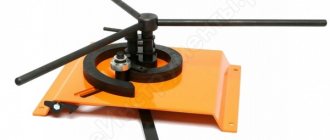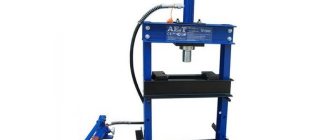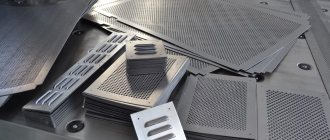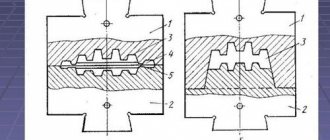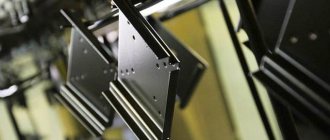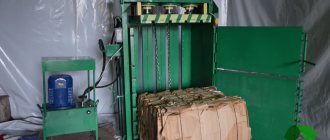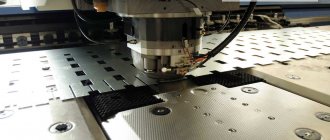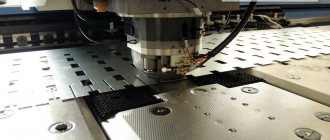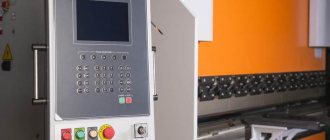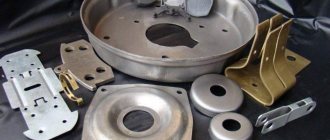Machines for performing forging and stamping operations (or rather, because some equipment is usually created for the developed technology, and not vice versa) are a common type of device for metalworking.
For example, in machine- and instrument-making enterprises or factories for the production of metal structures, for every 5 metal-cutting machines there is necessarily one piece of equipment for pressure processing. And not only metals: for example, the same PET bottles are produced on injection molding machines, which are also specialized stamping equipment.
Types of stamping technologies
The stamping process of processing blanks can be carried out using the hot or cold method. These technological varieties involve the use of special equipment and the use of certain metal processing conditions.
Cold stamping is one of the types of stamping
The hot stamping method processes workpieces that are preheated in special devices to a given temperature. Hot stamping is necessary when there is not enough equipment power to process a cold alloy. Heating devices can be electric or plasma ovens. This method requires accurate calculation of the parameters of the finished part, taking into account the shrinkage of the metal during the cooling process.
In cold stamping, parts are formed due to the mechanical pressure of the elements of the stamping press. Cold stamping is considered a more common method of metal processing. It does not require additional equipment, complex calculations or mechanical modification of parts. Thanks to this method, the strength properties of the material increase. The resulting products are distinguished by high surface quality and precision.
This is interesting: Radial drilling machine 2M55: characteristics and documentation
Forging and stamping
From the time man learned about iron, he began to look for ways to make it stronger, more reliable and at the same time give it the desired shape. Sponge iron was beaten with cold hammers to give the metal the desired shape and remove impurities from it. Then, to make it easier to solve this problem, they decided to beat it while it was hot. This method was called hot forging.
Forging is one of the most ancient methods of metal processing. In the distant past, the tools of a blacksmith’s labor were an anvil, a hammer and simple tools: bits, chisels, smoothers, etc. In the 16th century. hammers appeared that were driven by the energy of moving water (water drive).
This made it possible to increase the mass of the hammer (falling striker) by 10-15 times - up to 400 kg. The impact force of such a hammer naturally increased significantly. With the advent of steam engines, new opportunities opened up for increasing the force of a hammer blow. Almost simultaneously with the steam locomotive, the steam hammer was born.
Evolution of equipment development
Until the 15th and 16th centuries, almost all metal products were produced by private workshops and small workshops. However, the beginning of the Great Geographical Discoveries with the accompanying increase in the tonnage of sea vessels required the production of fairly large anchors and other ship equipment. It was no longer possible to forge such large parts by hand with a hammer. As a result, the first mechanical hammers powered by water power appeared.
Further, the impetus was the development of weapons and vehicles, and in the 19th century entire metalworking giants with steam equipment emerged.
The invention of hydraulic presses made it possible to introduce stamping as the main technology for mass production of products. And the further emergence of electric motors gave impetus to the development of crank presses, which form the modern basis of forging and stamping equipment.
Types of stamping equipment
To produce products from sheet metal, presses equipped with various stamps are used. During operation of the equipment, the upper component of the die moves, the lower part remains stationary.
Deformation of the workpiece occurs at the moment of contact between parts of the equipment. There are various models of stamping presses, which allows you to choose the right machine to produce the required parts.
Hydraulic Punching Machine
Presses for metal stamping are:
- crank type;
- hydraulic;
- radial forging type;
- electromagnetic type.
Crank presses are a simple type of equipment and can be double or triple acting. The presses got their name from the crank mechanism, which is the main structural element of the machine. The principle of operation of the mechanism is based on the transformation of rotational motion from the drive into reciprocating periodic movement of the press element - the slide.
Rotary and roller forging equipment
At large manufacturing enterprises, roller-type conveyor equipment is often used to perform forging operations. The workpieces are processed using the crimping method, which is performed by rotating rollers. Rotary forging machines operate on a similar principle, the processing of parts in which is also carried out during the rotation of the working bodies.
The rotational forging method ensures waste-free processing of workpieces
Specialists who professionally engage in forging and stamping operations have to solve a number of issues in order to obtain a product of the required quality. Among such issues, in particular, are the choice of equipment, the development and production of molds, and the equipping of machines with various tools and devices.
Operating principle and design of various types of presses
metal stamping workshop
Any standard stamping machine consists of the following main components: motor, transmission, actuator. The transmission and motor together make up the "drive". The main characteristic of the drive is the type of connection between the engine and the actuator: mechanical or non-rigid (liquid, gas, steam). Working parts of the press: rollers, slider, cross-beams, rollers, women.
Crank press
The machine drive rotates, the movement on the slide is converted to reciprocating.
Under the influence of this movement, the metal is processed using a stamp. All machine parts are made of durable steel and equipped with stiffeners. The movement of the slider occurs according to a strict schedule. The force on the slide reaches 8 thousand tons. Crank forging plants make it possible to speed up, simplify and reduce the cost of production of parts, saving up to 30% of rolled stock. All crank machines are divided into simple, double and triple action. The crank press is capable of performing the following types of work:
- stamping in open and closed dies;
- burr formation;
- extrusion;
- firmware;
- combined processing.
A mechanical press acts on the material with an impact, while a hydraulic press, applying less force, gets a greater effect. Therefore, the latter are used for the manufacture of large products with thick walls.
Hydraulic presses
Hydraulic Press
Capable of stamping surfaces, pressing and forging metal products. They are also used for recycling metal waste. The operation of the machine is based on increasing the force of pressure on the metal many times. The press consists of two communicating cylinders with water, between which a pipe passes. Pistons are installed in the cylinders. The operating principle of the press is based on Pascal's law.
Radial forging apparatus
Processes metal using the hot method. The blank enters the heating module, which operates on the induction principle. Here it is heated, when the metal becomes sufficiently pliable, it is fed through a conveyor to a gripping mechanism, which feeds the workpiece directly into the processing zone. Forging or stamping is carried out with strikers; during the process, the workpiece rotates all the time, due to which it is processed evenly on all sides. The press is powered by an electric motor connected by a V-belt drive to the shafts. They are placed vertically and direct movement to the connecting rod and striker, between which the slider is installed. To ensure that all movements of the mechanism are synchronous, there are copying drums. The blank holder is rotated by an electric motor through worm gears. The spring clutch slows down the movement at the right moments.
Electromagnetic press
This is the latest development, which is just beginning to be used in industry. The working body of the machine is the core of an electromagnet, which moves under the influence of an electromagnetic field. The core moves the slider or die, the springs return the slider to its original position. Such machines are characterized by high productivity and efficiency. Today, there are models with a small amplitude of movement of the working body - 10 mm and a force of no more than 2.5 tons.
Operation of a roughing stamping machine in the video:
Stamping press for sheet metal: types, design, operating principle
Stamping, which is performed using a metal press, is one of the most common technological operations for processing this material.
The essence of this procedure is to give a workpiece made of metal the required shape, for which plastic deformation is used, squeezing out a certain relief, patterns or punching holes.
Presses for metal processing, depending on the list of tasks for which they are intended, differ from each other both in their technical parameters and design.
Presses for metal processing are used in any production: small-scale, serial or mass production
Types of stamping technological operations and equipment
Stamping as a method of processing metal blanks can be:
The first implies that the metal is processed in a heated state. The great advantage of hot stamping is that when it is performed, the characteristics of the workpiece being processed are improved (in particular, the metal structure becomes denser and more uniform). Meanwhile, a layer of scale is not created on the surface of metal workpieces processed using cold stamping technology, and the dimensions of the finished products are more accurate and their surface is smoother.
Hot stamping often replaces forging, providing more accurate dimensional accuracy
Depending on the type of workpiece being stamped, such a technological operation can be sheet or volumetric. Stamping of the first type is used for processing sheet metal blanks; this technology is used to produce:
- dishes;
- jewelry;
- weapon;
- medical equipment and instruments;
- parts of watches, household, climate control and electrical equipment;
- parts for completing automotive equipment;
- parts of machine tools and other engineering products.
Stamping sheet metal on a coordinate turret press
Finished metal products obtained using sheet stamping technology do not require further refinement. The formation of their geometric parameters when performing volumetric stamping occurs in special forms in which hot or cold metal is subjected to extrusion.
The press machine is usually used for:
- production of metal blanks by forging;
- pressing and pressing out of shafts, bearings and gears;
- performing sheet and volume stamping.
According to the principle of operation, pressing machines can be of the mechanical or hydraulic type and perform metal processing using static or impact methods.
The single-crank mechanical press K2130 is a double-column type equipment
Mechanical pressing equipment can be designed according to its design:
- eccentric;
- crank.
Crank machines are used for both cold and hot metal stamping. This stamping equipment is also used to perform such technological operations as drawing, cutting and cutting. The hydraulic press is used for stamping and forging technological operations with bulk metal blanks.
Metal cold processing stamping shop
According to their functionality, pressing machines are divided into the following types:
- universal;
- special;
- specialized.
A universal pressing machine has the widest functionality; such equipment can be used to perform almost any forging operation. Specialized dies or presses are used to implement one technological process. Special presses that are used for stamping products of one type have minimal functionality, while their operation is based on one technology.
Design and principle of operation of pressing equipment
The design of any stamping equipment consists of the following elements:
- drive motor;
- motion transmission mechanism;
- actuating mechanism.
Main parts of mechanical crank press
Depending on how the drive motor of the press is connected to its actuator, machines with a connection are distinguished:
- mechanical;
- non-mechanical, carried out by liquid, gas or steam.
The actuating mechanism with which equipment for stamping is equipped can be traverses, a slider, rolls, rollers and women.
Crank type presses
The main structural element of these presses is the crank mechanism, which converts the rotational motion it receives from the drive into the reciprocating motion of the slider. The actuator, which is equipped with a stamping press of this type, is connected directly to the slider, capable of developing a force of up to 100 tons. The movement of the slider in such presses occurs at the same frequency.
Crank press assembly die
Crank-type presses can be simple, double or triple acting equipment. Using such machines, you can perform the following technological operations:
- stamping using open and closed type dies;
- sheet metal cutting;
- firmware;
- formation of the finished product by extrusion;
- combined processing.
In cases where more powerful equipment is required to form a finished product from a metal billet, hydraulic type machines are used.
ESSA crank press machine
Radial forging presses
A radial forging machine is a forming press on which preheated metal blanks are converted into finished products of a cylindrical configuration. The design of presses of this type is:
- an induction furnace in which the workpiece is preheated;
- conveyor for feeding the workpiece into the processing zone;
- gripping mechanisms, with the help of which the metal part being processed, constantly rotating, passes through the forging zone;
- a worm gear connected to an electric motor and responsible for the operation of the gripping mechanisms;
- four shafts with eccentric axle boxes that transmit movement to a connecting rod with a striker, between which a slider is fixed (the shafts themselves, through a V-belt transmission, receive rotation from the drive electric motor);
- copying drums, responsible for the synchronous approach of the strikers and the subsequent movement of the workpiece;
- a spring clutch that provides braking of the part while it is being processed by the strikers.
Radial forging machine is used to produce square or round forgings close to the profile of finished products
Features of open and closed dies
Closed stamping
Stamping equipment can be equipped with open or closed dies. In an open die, excess metal flows into a burr or flash that performs a specific function. The main disadvantages of this technology are: loss of alloy due to flash, reduction in product quality due to cut fibers when removing burrs.
Closed dies are used to produce simple shaped products. This flash-free technology is characterized by metal savings, no costs for cutting burrs, and high product quality due to all-round compression. Metal fibers are not cut. The closed die processing method is used for low-plasticity alloys. The main disadvantages are: the need for precise dosage of the alloy, the complex design of the die.
In modern manufacturing, stamping is primarily a preparatory operation that allows the production of parts for both electronics and aircraft or watercraft. The resulting products are subsequently subjected to welding, cutting, riveting and other processing methods depending on the technological process.
Related video: Sheet stamping
This is interesting: Types and characteristics of welding inverters
Overview of IPONMAC presses and their characteristics
| Model series | KD 23D | HL41 | PG41 |
| Nominal force, t | 10-80 | 40-315 | 40-315 |
| Opening height/clearance, mm | 130-280 | 800-1600 | 800-1600 |
| Table/bottom plate size, mm | up to 520*860 | up to 1400*1200 | up to 1400*1200 |
| Drive power, kW | 1,1-7,5 | 5,5-30 | 5,5-30 |
| Weight, kg | 600-5280 | 3000-36000 | 3-36000 |
Design features
All units for processing metal workpieces have approximately the same structure. Three main nodes can be distinguished. These include:
- equipment engine;
- torque transmission;
- actuating mechanism.
The first nodes form the drive system, on which the functioning of the actuator depends. Each organ is responsible for a specific result. Therefore, you should understand what types of machines there are.
Hydraulic and crank type stamping presses
From the moment people learned to perform metal forming, the work of the specialist who did it was considered one of the most honorable. Over time, the need for metal products obtained using forging technology only increased, and the actively developing industry began to need them. All this led to the fact that for forging, not the manual labor of blacksmiths, but special equipment for stamping was used.
A fairly common type of device used for forging is a kind of hammer analogue - a stamping press. Using such stamping equipment, it is possible to perform a whole list of technological operations, namely: changing the shape of the workpiece by means of its plastic deformation, forming a given relief on its surface, cutting out individual fragments, etc. On such a device, in particular, they give shape to the workpieces for the manufacture of which casting was used. Presses used for stamping operations can be crank or hydraulic.
Press diagrams: a – vertical hydraulic; b – horizontal; c – crank; g – friction; d – hydraulic screw
A crank press is used in cases where it is necessary to perform simple metal forming by pressure. The main element of such equipment, which converts the rotational movement of the drive motor shaft into reciprocating movement of the slider, is the crank mechanism. That is why a crank press is often called a stamping crank press. It is very popular both among manufacturers and private craftsmen; there are even models of a tabletop crank press. This popularity is explained not only by the high efficiency and functionality of this equipment, but also by the fact that maintenance and repair of crank presses does not cause any special problems.
Hydraulic stamping press 4-column
Hydraulic stamping presses are equipped with two working chambers in which the required pressure is created in the working fluid. The liquid under pressure enters the cylinder with another piston, through which reciprocating motion is imparted to the slide.
Technology of stamping parts from sheet metal. Equipment
The production of parts using stamping occupies a leading place in metal forming technology and is used in various industries.
Of particular importance is the stamping of metal products from rolled sheets. It is based on plastic deformation of metal without heating it using special stamps. This method of plastic deformation of parts is widely used for the manufacture of parts of different sizes and complex shapes with great accuracy, which cannot be achieved using other processing methods.
They are used for assembling large-sized products in the engineering industry, in the automotive and shipbuilding industries, as well as in the instrument-making industry and everyday life, where various miniature parts are often required.
Cold stamping of sheet metal
The technology of cold deformation of rolled sheets using stamps involves changing the shape and dimensions of the product while maintaining their original thickness.
As a material for producing cold stamped products, strips, sheets or thin tape are used mainly from low-carbon and alloyed ductile steels, as well as copper, brass (containing over 60% copper), aluminum, magnesium, titanium and other ductile alloys. The use of alloys with good ductility for stamping is due to the fact that they are easily subject to deformation changes.
To carry out cold stamping of sheet metal, various operations are used, which depend on the task of achieving a certain shape of the workpiece. They are divided into separation and shape-changing effects.
1. During separation deformations, the workpiece material is partially separated along a given contour. Separation is carried out by shifting part of the metal in relation to the main workpiece. Such operations are cutting, cutting, punching and others.
Let's consider how some separation operations are carried out.
Metal stamping press
All cold stamping operations can be carried out with special equipment, the main one of which is a stamping press. Its device can be based on mechanics or using hydraulics.
Mechanical types include:
- eccentric presses;
- presses using a crank mechanism.
A crank-type stamping press is used to carry out punching, punching and drawing operations.
Design and principle of operation of a crank-type press
Any press intended for stamping products includes main components, which include: a mechanism that drives it and a device that carries out direct stamping.
The operating mechanism is a crank shaft, which is driven by an electric drive. To do this, the electric motor, when the flywheel rotates, transmits rotation to the crank mechanism using a gear transmission.
Performing reciprocating actions, the crank slide drives a stamping device, which, with a pressure force, produces plastic deformation.
The main parts of such a press are made of high-strength steels and are additionally strengthened in order to impart the necessary rigidity.
:
Hydraulic press device
A hydraulic metal stamping press is used to create three-dimensional shapes by pressing metal.
The principle of operation of such a mechanism is based on the pressure of a liquid placed in two reservoirs, which are equipped with pistons. The tanks are connected by pipeline. As a result of the pressure in the liquid that arises at the moment it is pumped into the cylinder from another reservoir, it is transmitted to the slide and sets it in motion. When moving, the slider presses the workpiece with great force.
Types of technological operations
Technological operations with metal sheets are separating and forming.
Separation stamping operations are performed on equipment equipped with special tools. As a result, a certain part is separated from the workpiece along a straight line or a given contour. The separation of part of the sheet occurs in the following processes:
- Segment _ To perform this action, the equipment is equipped with disk, vibration devices or guillotine shears.
- Trimming . This operation separates the extreme parts of the resulting product.
- Punching . Holes of various configurations are created in a metal sheet using a stamp.
- Felling . A shaped part with a closed contour is obtained from the workpiece.
Form-changing operations are intended to create a product with different parameters and dimensions without mechanical destruction. The following types of these operations are distinguished:
- Beading. The contour of the workpiece or the internal holes are exposed to the stamp to form beads of certain sizes.
- Hood. This operation is a type of volumetric stamping, in which a spatial element is obtained from a flat material.
- Crimping To narrow the ends of a hollow workpiece, a stamp with a conical-type matrix having a narrowing working area is used.
- Flexible. As a result of the operation, the curvature of the surface changes by bending the metal and deforming the workpiece.
- Molding is a change in the shape of individual sections by reducing the thickness of the part without disturbing the external contour of the product.
- Puklyovka. Connecting two plates with a stamp without using additional elements.
Stamping of sheet metal parts
One of the most common metal processing technologies is stamping. With its help, parts are produced for all sectors of the national economy. The use of stamping makes it possible to obtain parts of different sizes and shapes from a flat sheet.
Sheet metal stamping
Technology of stamping parts from metal sheets and its types
Sheet metal processing is the process of obtaining parts of the required shape and specific size. The work of forming parts takes place on special equipment using a tool called a stamp.
When talking about parts made from sheet metal, you need to understand that serious pressure is put on the workpiece. Stamping technology began to be used in ancient times. Thus, they produced tools for cultivating the land, dishes, and jewelry.
Stamping of parts from metal sheets
Nowadays, this technology is widely used in the production of sheet metal parts of different sizes and shapes. This type of processing is widely used in automobile construction in the production of body parts.
Cold and hot sheet metal stamping
The production of sheet metal parts can be done cold or hot.
Cold stamping
The use of cold forming is considered the most effective way to process sheet metal. The use of this method is carried out in cases where there is no need for further mechanical processing, for example, cutting. This method of obtaining parts is most often used in the manufacture of automotive parts, structural elements of aircraft, and a number of others.
Using the method of cold metal forming allows for significant savings in sheet metal, of course, with proper cutting of the sheet and correctly manufactured die equipment. Stamping is most effective in large-scale and mass production.
This method shows the greatest efficiency when working with steels such as carbon and alloy. In addition, parts made from many non-ferrous metals, such as copper or aluminum alloys, are produced by stamping.
Cold stamping of sheet metal
In addition to sheet metals, the sheet stamping method can also be used to produce parts from rubber, cardboard and many polymers.
By the way, such metal processing improves its strength parameters.
Hot stamping
This method of sheet metal processing is used in the production of parts for boiler plants and some parts used in shipbuilding. For such parts, steel sheets with a thickness of 3–4 mm are used.
The technological operations used in hot stamping are in many ways similar to those used in cold sheet metal processing. Engineers developing sheet metal processing technologies must take into account that the parts must be heated to a certain temperature. Accordingly, phenomena such as sheet metal tightening must be taken into account when making holes, bending and a number of others. In addition, when parts cool, it is necessary to remember about the resulting warping.
Hot stamping of sheet metal
All this leads to changes in the tolerances on the dimensions of parts produced from metal.
Before processing on pressing equipment, metal blanks are heated in various types of furnaces, for example, electric or gas-flame.
Radial forging equipment for hot metal processing
A radial forging machine is used to produce shafts of various diameters with high productivity. With such a unit it is possible to set up production of up to 300 thousand finished products per year, which is quite enough to supply a large manufacturing enterprise with them.
The limited use of such a machine for metal stamping is explained not only by its high cost, but also by the fact that setting up its operating modes is a rather complex process, so it is advisable to perform it only if you plan to produce products of a certain diameter in large quantities.
Radial forging machine (RFM) ensures high stamping accuracy, producing parts with minimal allowances
The sequence of actions during which radial forging is performed is as follows.
- The part is fed into an induction device to bring it to the required heating temperature.
- After the metal acquires the required degree of plasticity, the part is sent along a roller container (rolling table) to a gripping device, with the help of which it is fed into the processing zone.
- There, the workpiece is fixed by elements of another gripping device, after which it is acted upon using special strikers.
- To ensure uniform processing on all sides, the part is constantly rotated, for which a special gripping mechanism is used.
Schemes of operation of forging machines of radial and rotary type
In order to set in motion the working mechanism of equipment for radial forging, a kinematic diagram is used, the elements of which are:
- drive motor;
- V-belt transmission;
- four vertically mounted shafts with eccentric axle boxes;
- a connecting rod with a striker and a slider attached to it.
The main automatic elements of the machine are the tracing drums, which are responsible for both the synchronous approach of the strikers and the subsequent movement of the workpiece. The rotation of the grip in which the workpiece is held is imparted by an electric motor through the worm gear elements. The braking of this mechanism, which occurs during forging, is provided by a spring clutch.
» data-lazy-type=»iframe» src=»data:image/gif;base64,R0lGODlhAQABAIAAAAAAAP///yH5BAEAAAAALAAAAAABAAEAAAIBRAA7″>
One of the types of forging equipment is a horizontal forging machine, in which the workpiece is also located parallel to the ground. Devices of this type are used primarily for forming end thickenings on rod-type workpieces. During processing, the part is located in a split matrix, the channels of which are oriented in the horizontal plane.
The processing process performed on such a machine occurs in the following sequence.
- The workpiece is placed in the stationary part of the matrix.
- The moving part of the matrix, connected to the slider, is driven by the crankshaft.
- Approaching the stationary half of the mold, the movable part of the matrix tightly covers the processed rod.
- After clamping the part with the top of the mold, the crankshaft connected to the connecting rod drives the impact punches.
- At the end of processing, all moving parts of the machine return to their original position, and the moving and stationary parts of the mold are opened.
» data-lazy-type=»iframe» src=»data:image/gif;base64,R0lGODlhAQABAIAAAAAAAP///yH5BAEAAAAALAAAAAABAAEAAAIBRAA7″>
Air driven forging hammer
A pneumatic press is an efficient, but at the same time affordable forging equipment, which is also distinguished by its compact dimensions. This machine operates using the energy of compressed air, which is supplied to the mechanisms by a built-in compressor. The operation of the compressor, the pistons of which, moving in its main cylinder, create an air flow with the required pressure, is ensured by a drive electric motor.
Since the impact mechanism of a pneumatic forging machine is operated by a crank, its design resembles that of a crank press. Before starting such equipment, the compressor and working pistons in the master cylinder are in their highest and lowest positions. When the machine is put into operation, the pistons begin to move towards each other, compressing the air between them, the pressure of which is transmitted to the crank, directly connected to the striker. For one blow of the working part of the hammer of a pneumatic machine there is one revolution of the crank mechanism. Accordingly, in order for the hammer to act on the workpiece at a higher frequency, it is necessary to ensure more intensive operation of the compressor. Even despite its small dimensions, a pneumatic press can provide a hammer impact weight of up to 1 ton.
Pneumatic forging hammer MA-4129 is designed for hot stamping in open dies
A steam-air hammer operates on a principle similar to a pneumatic press, in which the impact energy is provided by hot steam supplied directly from the boiler or through a special compressor. The mass of impacts that such equipment allows to achieve can reach up to 8 tons, and the speed of their application is 50 m/sec. Depending on the model, it can work in automatic mode, when blows are applied to the part continuously, or in manual mode, when the corresponding button or pedal must be pressed to activate the striker.
Mechanical hammers can be used for:
- free forging or forging operations in which a mold is used to form the finished product;
- stamping operations with sheet metal parts - cutting along a straight or curved line, cutting along various contours, punching holes (punching press), etc.;
- punches - making products using a special template.
